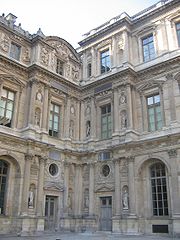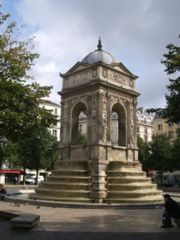
Pierre Lescot
Encyclopedia

France
The French Republic , The French Republic , The French Republic , (commonly known as France , is a unitary semi-presidential republic in Western Europe with several overseas territories and islands located on other continents and in the Indian, Pacific, and Atlantic oceans. Metropolitan France...
architect
Architect
An architect is a person trained in the planning, design and oversight of the construction of buildings. To practice architecture means to offer or render services in connection with the design and construction of a building, or group of buildings and the space within the site surrounding the...
active during the French Renaissance
French Renaissance
French Renaissance is a recent term used to describe a cultural and artistic movement in France from the late 15th century to the early 17th century. It is associated with the pan-European Renaissance that many cultural historians believe originated in northern Italy in the fourteenth century...
, "the man who was first responsible for the implantation of pure and correct classical architecture in France." He was born in Paris.
King Francis I
Francis I of France
Francis I was King of France from 1515 until his death. During his reign, huge cultural changes took place in France and he has been called France's original Renaissance monarch...
of France took him into his service, and appointed him architect in charge of the building projects at the Palais du Louvre
Palais du Louvre
The Louvre Palace , on the Right Bank of the Seine in Paris, is a former royal palace situated between the Tuileries Gardens and the church of Saint-Germain l'Auxerrois...
, which transformed the old château into the palace that we know. A project put forward by the Italian architect and theorist Sebastiano Serlio
Sebastiano Serlio
Sebastiano Serlio was an Italian Mannerist architect, who was part of the Italian team building the Palace of Fontainebleau...
was set aside in favor of Lescot's, in which three sides of a square court were to be enclosed by splendid apartments, while on the east, facing the city as it then was, the fourth side was probably destined to be lightly closed with an arcade. Festive corner pavilions of commanding height and adorned by pillars and statues were to replace the medieval towers. Elsewhere in the Louvre, little was actually achieved beyond razing some of the old feudal structure.

Henry II of France
Henry II was King of France from 31 March 1547 until his death in 1559.-Early years:Henry was born in the royal Château de Saint-Germain-en-Laye, near Paris, the son of Francis I and Claude, Duchess of Brittany .His father was captured at the Battle of Pavia in 1525 by his sworn enemy,...
, and though he worked at the Louvre project until his death, only the west side and part of the south side were completed, comprising the present southwest wing of the Cour Carré, the Aile Lescot, or "Lescot Wing" (illustration). Even so, the building executed in 1546–51 set the mold of French classicism: it is of two stories with an attic richly embellished with Jean Goujon
Jean Goujon
Jean Goujon was a French Renaissance sculptor and architect.-Biography:His early life is little known; he was likely born in Normandy and may have traveled in Italy...
's panels of bas-reliefs; it is crowned by a sloping roof, a traditional feature of French building and practical in a rainy climate. The deeply recessed arch-headed windows of the ground story give the impression of an arcade, while the projecting central and end pavilion
Pavilion
In architecture a pavilion has two main meanings.-Free-standing structure:Pavilion may refer to a free-standing structure sited a short distance from a main residence, whose architecture makes it an object of pleasure. Large or small, there is usually a connection with relaxation and pleasure in...
s bear small round oeil de boeuf windows above them. In the second storey slender fluted pilaster
Pilaster
A pilaster is a slightly-projecting column built into or applied to the face of a wall. Most commonly flattened or rectangular in form, pilasters can also take a half-round form or the shape of any type of column, including tortile....
s separate the windows, which alternate delicate triangular and arched pediments. Goujon's noble sculpture and architectural ornaments are cleverly subordinated to the construction, but the surviving groundfloor Salle des Caryatides (1546–49) is named for Goujon's four caryatid
Caryatid
A caryatid is a sculpted female figure serving as an architectural support taking the place of a column or a pillar supporting an entablature on her head. The Greek term karyatides literally means "maidens of Karyai", an ancient town of Peloponnese...
figures that support the musicians' gallery. Of Lescot's constructions at the Louvre there also remain the Salle des Gardes and the Henry II staircase.

Saint-Germain l'Auxerrois
The Church of Saint-Germain-l'Auxerrois is situated at 2, Place du Louvre, Paris 75001; the nearest Métro station is Louvre-Rivoli.Located at the center of Paris, by the Seine and near the Louvre, this former parish of the kings of France is generally regarded as the Church of the Louvre...
, of which only some sculptures by Goujon have been saved and in Paris the Hôtel de Ligneris (1548–50, now the Musée Carnavalet, which was thoroughly altered by François Mansart
François Mansart
François Mansart was a French architect credited with introducing classicism into Baroque architecture of France...
). Here and especially in the design of the Fountain of Nymphs
Fontaine des Innocents
The Fontaine des Innocents is a monumental public fountain located on the place Joachim-du-Bellay in the Les Halles district in the 1st arrondissement of Paris, France. Originally called the Fountain of the Nymphs, it was constructed between 1547 and 1550 by architect Pierre Lescot and sculptor...
(1547–49, illustration, right), his moderate tectonic role is outshone by Goujon's sculpture. He was also responsible for the Château de Vallery
Château de Vallery
The Early Renaissance French Château de Vallery, in Vallery, in the département of Yonne in the Burgundy region of France, was built in 1548 for Jacques d'Albon de Saint-André, marquis de Fronsac, a court favorite of Henri II and maréchal de France. It was never completed, and what remains of it...
.
Lescot's career is so scantily documented it is not known whether he ever visited Italy, or whether his knowledge of Italian practice was derived through the architecture and engravings that issued from the School of Fontainebleau
School of Fontainebleau
The Ecole de Fontainebleau refers to two periods of artistic production in France during the late Renaissance centered around the royal Château de Fontainebleau, that were crucial in forming the French version of Northern Mannerism....
. All of Lescot's known works have sculptural decoration by Trebatti and by Jean Goujon
Jean Goujon
Jean Goujon was a French Renaissance sculptor and architect.-Biography:His early life is little known; he was likely born in Normandy and may have traveled in Italy...
, who collaborated with him at the Louvre. Unlike the other architects of the French Flamboyant Gothic and Renaissance, Pierre Lescot was not from a line of masons, with practical experience, but the son of a seigneur. His father, also Pierre Lescot, was sieur of Lissy-en-Brie and Clagny
Château de Clagny
The Château de Clagny was a French country house that stood northeast of the Château de Versailles; it was designed by Jules Hardouin-Mansart for Madame de Montespan between 1674 and 1680...
, not far from Versailles, seigneuries that his son Pierre inherited. Although, according to a eulogistic poem by Ronsard, Pierre Lescot busied himself zealously in early youth making drawings and paintings, and, after his twentieth year, with mathematics and architecture, his wealth and the duties of his offices appear subsequently to have interfered with his artistic activity. No other documented works are identified, though a dismissive reference in the memoires of the duc de Nevers, published long afterwards, instances "Magny" (i.e. Clagny) as "a painter who used to make inventions of masquerades and tourneys", as all court architects were expected to produce in the fifteenth to seventeenth centuries.
At his death, Lescot was succeeded at the Louvre by Jean Baptiste Androuet du Cerceau
Androuet du Cerceau
Androuet du Cerceau was a family of French architects and designers active in the 16th and early 17th century.*Jacques I Androuet du Cerceau *Jean Baptiste Androuet du Cerceau...
.
See also the other outstanding architects of the French Renaissance:
- Philibert Delorme
- Jean BullantJean BullantJean Bullant was a French architect and sculptor who built the tombs of Anne de Montmorency, Grand Connétable of France, Henri II, and Catherine de' Medici. He also worked on the Tuileries, the Louvre, and the Château d'Écouen...
- Androuet du CerceauAndrouet du CerceauAndrouet du Cerceau was a family of French architects and designers active in the 16th and early 17th century.*Jacques I Androuet du Cerceau *Jean Baptiste Androuet du Cerceau...
, a dynasty of designers and architects - Jean GoujonJean GoujonJean Goujon was a French Renaissance sculptor and architect.-Biography:His early life is little known; he was likely born in Normandy and may have traveled in Italy...
External links
- Catholic Encyclopedia 1908: "Pierre Lescot"
- Imago Mundi: Pierre Lescot (in French)

